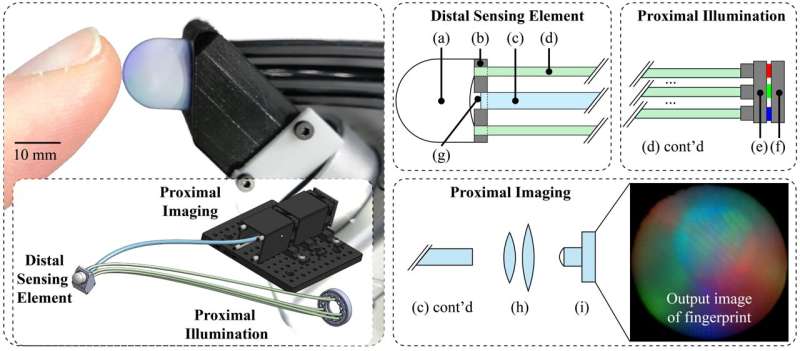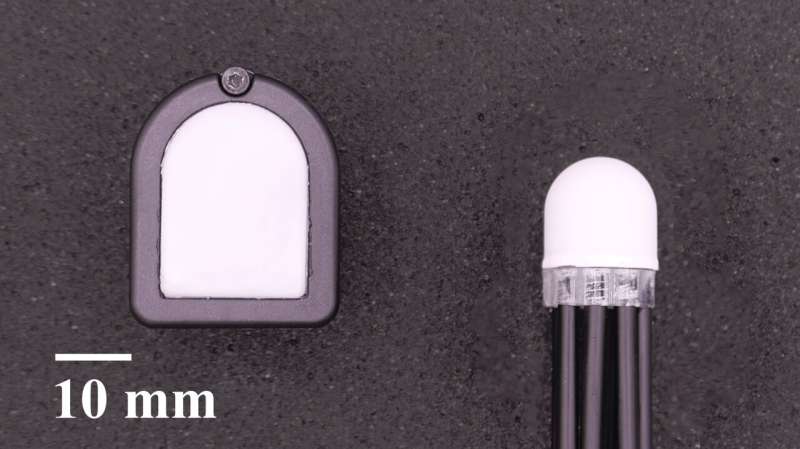April 9, 2024 feature
This article has been reviewed according to Science X's editorial process and policies. Editors have highlighted the following attributes while ensuring the content's credibility:
fact-checked
preprint
trusted source
proofread
A miniaturized vision-based tactile sensor based on fiber optic bundles

Researchers at Meta AI, Stanford University, Technische, Universität Dresden and the German Cancer Research Center (DFKZ) recently developed DIGIT Pinki, a miniature-sized sensor that can detect tactile information. This sensor, presented in a paper posted to the preprint server arXiv, could be integrated in new medical technologies and robotic systems.
"This paper started with a research internship at Meta AI with Roberto Calandra and Mike Lambeta, but eventually grew into a research collaboration between Meta, Stanford University, Technische Universität Dresden, and the German Cancer Research Center (DFKZ)," Julia Di, co-author of the paper, told Tech Xplore.
"We are primarily interested in the science of digitizing touch for robots. With the DIGIT Pinki, we wanted to investigate how to build sensors that have touch capabilities resembling those of humans but in the form factor of a human finger."
DIGIT Pinki, the sensor created by Di and her colleagues, builds on tactile sensor designs introduced in recent years, such as the DIGIT and OmniTact sensors. To create their device, however, Di and her colleagues also revisited older design ideas introduced in the 1980s, including those outlined in a seminal paper by S. Begej.
"DIGIT Pinki is a type of vision-based tactile sensor that uses images from a miniature camera to get a sense of touch," Di explained. "Usually, these kinds of sensors are made up of an optically clear gel fingertip. When these gel fingertips touch an object or the environment, an internal camera with lights will take images of the resulting deformations in the gel."
The researchers trained a machine learning algorithm on the deformations of the sensor's gel, produced when the sensor makes contact with an object. The trained algorithm can accurately learn tactile information, such as the contact forces with an object, from the image data collected by the sensor. This tactile information could then be used by a robot or device to complete manipulation tasks.

"Our innovation was to shrink sensors by using fiber optic bundles to relay the image to a remotely located camera, akin to how early endoscopes used fiber optic bundles for imaging," Di said. "By moving the electronics away from the gel fingertip, we could shrink the gel fingertip substantially. One benefit of this design is that the gel fingertip is non-magnetic and contains no electronics, a boon for any tasks in medical applications like inside the body or in an MRI machine."
The recent work by this team of researchers demonstrates the feasibility of miniaturizing vision-based tactile sensors using fiber optic bundles. Following their proposed design, Di and her colleagues created a prototype sensor with a tip diameter of 15 millimeters, which is approximately the average size of a woman's index fingertip or the size of the bottom 5% of a male index finger.
Notably, this artificial, sensing fingertip is made of silicone and contains no sensitive electronic or magnetic components. This means that it could be safely introduced in the human body and may thus be attractive for medical applications.
"One real-world application for a slim, sensitive sensor is cancer diagnostics in constrained spaces—for example, digital palpation in routine rectal or cervical exams," Di explained. "Because cancer nodules are a bit stiffer than healthy tissue, clinicians may feel cancerous growths with their fingertips as a diagnostic method.
"In the paper, we present preliminary results showing DIGIT Pinki discriminating between healthy and unhealthy tissue on both medical-grade phantoms (simulations of real tissue) and ex vivo posterior prostate tissue (the part of the prostate that would be felt during a clinical examination)."
The results of the team's preliminary tests suggest that DIGIT Pinki could be used to develop new medical technologies, including devices that can detect tissue abnormalities inside the human body. In addition, the sensor could be used to develop new robotic systems, such as slim and sensitive artificial fingertips that allow robots to manipulate objects with greater dexterity and even use scissors or other tools that require the application of controlled forces onto a constrained location.
"In the immediate future, we are working on extending this technology for other medical applications, for example, to palpate the cervix," Di added. "It would be exciting to have these kinds of highly sensitive fingertips on prosthetic hands too. We are also interested in discovering how to use artificial intelligence to interpret touch signals for manipulation. "
More information: Julia Di et al, Using Fiber Optic Bundles to Miniaturize Vision-Based Tactile Sensors, arXiv (2024). DOI: 10.48550/arxiv.2403.05500
© 2024 Science X Network


















